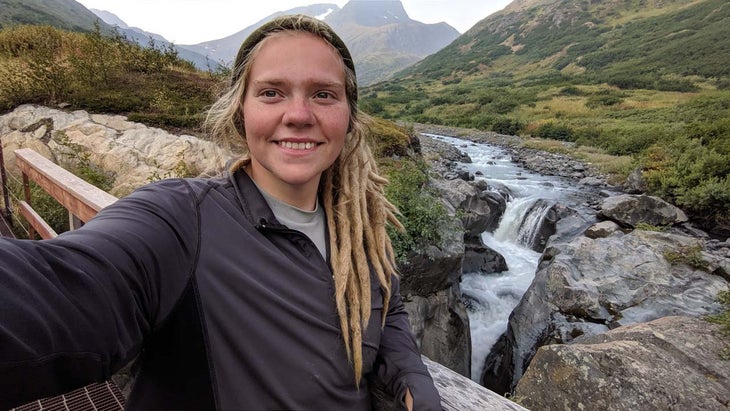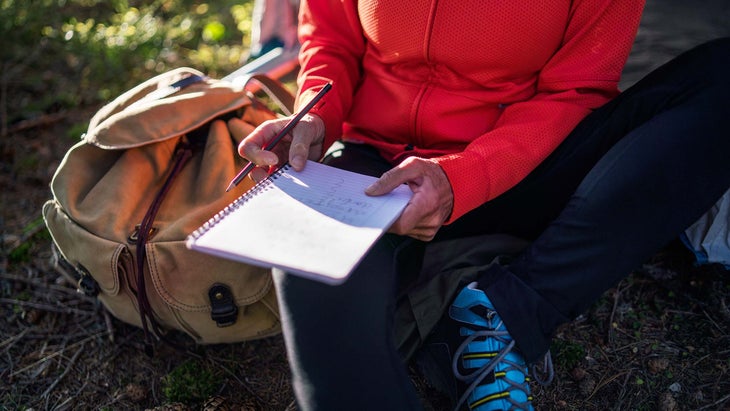Products You May Like
Get full access to Outside Learn, our online education hub featuring in-depth fitness, nutrition, and adventure courses and more than 2,000 instructional videos when you sign up for Outside+
Sign up for Outside+ today.
Hearing people often throw around the word “silence” when they talk about hiking. It’s common to frame the sounds of nature—waterfalls, birds, wind through the trees—as a form of silence, an escape from the noise of our urban, technology-heavy lives. But my experience with silence is a little different.
After carrying myself up to the top of Vernal Falls in Yosemite Valley, I sat down on a boulder right next to the gushing cascade to let my knees recuperate before tackling the next set of stairs. I inhaled the damp air and absorbed the view of the waterfall, a miniature rainbow arcing through its mist. The water was ferociously bubbling over rocks and branches. Instead of relying on the audible “silence” that nature has to offer, I felt the muted vibrations making their way through the rocks. It was incredible to see how soft and calm the waterfall looked from a distance, yet the pulse rumbling through my legs and entire body told me just how powerful it was. If a sound description is necessary here, I would take a wild guess and say the water was burbling. It was absolutely peaceful, and for a moment, I had it all to myself.
However, after a few minutes of absentmindedly appreciating the cascade through a natural frame of trees, a familiar sensation came over me: the warbled sounds of humanity. I glanced around to find the possible source and found a hiker standing a few feet away, gawking at me with wide eyes. Their body language clearly indicated that they had been yelling something behind my back for who knows how long. Maybe they were confused or wondered if I was flat-out ignoring them. Quickly and instinctively, I said and gestured “I’m Deaf.” The hiker had their mouth covered by a bandana (Covid regulations were still in effect in the national parks). They continued to speak louder, as if my hearing would magically start working at any moment. My eyes darted back and forth, attempting to find a way to ease communication.
The hiker only got louder and louder (it didn’t help). Again, I told them that I was Deaf and couldn’t hear them, while silently pointing at my ears and shaking my head. (Deaf people and ASL users know what’s up here). I let the hiker have a minute to process the fact they had unexpectedly bumped into a Deaf person.
The confused hiker still struggled to grasp the simple gesture of “I-didn’t-and-still-don’t-hear-you.” They fluttered around, unsure of what to do. As usual in situations like this, I suggested by gesturing that they could write (or type) what they were trying to communicate instead. Upon realizing that they wouldn’t be able to use spoken language, the hiker shrugged, and began backing up toward the trail.

I felt my heart crack a little at the communication barrier that had come between us at that moment. Not for the first time, I had put in the effort to understand, and they hadn’t. Instead of looking at the waterfall again, I dully watched the hiker trudge down the stone steps for the next five minutes.
After they left, I felt distracted, unable to enjoy the scenery. What if the hiker wanted to tell me something incredible they had just witnessed? What if they needed to warn me about something? What if there was an emergency and they needed my help? Or did they just want to say hi and connect?
This kind of encounter is a common occurrence for the Deaf and hard of hearing (HoH) community. On some days, it seems like the act of finding an alternative method of communication is simply too much of an inconvenience for the hearing community. The outdoors have become more accessible over the past few years, and I’m grateful for that. But situations like this still leave Deaf, DeafBlind, HoH, and many other people feeling perplexed and diminished, especially after all the effort and resources we try to provide. Communication is very much possible, but only if everyone truly understands how to use the tools available.
As many have noted, there’s been a massive influx of people into the outdoors since the pandemic began. That’s great, but it has taken a toll on those who rely on facial expressions and lip-reading, which the adoption of face masks only made worse. At the peak of the mask mandates, I immersed myself into nature hoping that I wouldn’t have to deal with more communication barriers. After all, nature is supposed to be a place where everyone can interact directly with the world around them, even if they’re missing at least one of their five senses.
To effectively collaborate with people with disabilities toward the goal of making our outdoor spaces more accessible, please listen with your eyes (or your preferred alternative method if seeing is not an option). If the anxiety of not knowing sign language is your main hurdle, read to the end of this piece for a snippet from a resource pamphlet that I created a few years ago for my capstone project at Rochester Institute of Technology, titled Here’s How To Feel Less Awkward Around Deaf People. Keep in mind that the guidelines might not be exactly applicable to the wilderness, where phones or computers are not always readily available. However, that’s the perfect opportunity to become even more creative: You would be surprised at how effective gesturing or writing in the dirt with a twig can be.
I’m not the only Deaf hiker out there. There’s a large community in the outdoors who identify variously as Deaf, Hard-of-Hearing, DeafBlind, and more. Having hearing loss is not necessarily a binary switch, which is a common misconception. Often, society seems to think that you’re either fully deaf or hearing. The spectrum of hearing loss is truly diverse. Personally, I often find my silence in the wilderness because nature allows me to just be, without dwelling on communication barriers. Unless another hiker creates one, that is.
The unintentionally ignorant hiker back at Vernal Falls assumed that, because I looked capable of hearing whatever they had originally wanted to say, I could, and was choosing not to; the reality here is my disability is completely invisible. If the hiker had just walked by unaware of my deafness, I would have kept gazing at the mesmerizing scenery, without the interruption of humanity, or at least without the experience of running into a brick wall when I tried to communicate. Building connections with other people outdoors is just as meaningful as actually getting out of your door, but when hearing hikers create communication barriers, it takes something away from our experience in the wilderness. It’s no longer a relief from the hustle of daily life, just a reminder of it.
Hiking in silence is the only type of hiking I will ever experience, which I’m perfectly okay with. Birds chirping, rustling leaves, squirrels squealing, water rushing, and all that—I don’t hear them in the same way you all do. Instead, I see, feel, smell, and (sometimes) taste them. When it comes to creating vivid memories, that’s more than enough.

What a Deaf Hiker Wants Hearing Hikers to Know
Stay calm and be patient with us. Our deafness is not contagious, we promise.
First of all, remember that Deaf/HoH people are just like you, except for our hearing level.
Don’t panic because you know few or no signs. Use gestures! Even basic sign language is helpful, but if you don’t know any, it’s not the end of the world.
Talk normally and clearly, face the person, and maintain eye contact. Do not over-enunciate or exaggerate your speech. Be willing to repeat or rephrase when asked to. If needed, seek alternative communication options such as a paper and pen or a mobile device.
Communication Option 1: Write it Down
Find any piece of paper and please write large and clear. Yes, use a napkin or even toilet paper if you have to—any surface you can write on works.
Communication Option 2: Go High-Tech
Pull out your mobile device and chat through typing or speaking into it! It is helpful if the words are large and easy to read. There are many useful note taking or speech-to-text apps that you can use for conversations such as your regular Notes, BigNote, Ava, Microsoft Translator, Google Translator, and more!
Remember That Deafness is Not “One-Size-Fits-All”
All Deaf/HoH people are different. It would be a good idea to let us take the lead in conversations. We do it every day, so we know what works best.
Some Deaf/HoH people:
- Use voice and lipreading while some don’t.
- Use sign language while some don’t.
- Use both sign language and voice.
- Rely on hearing aids or a cochlear device.
- Can hear some, while others don’t at all.
However, don’t make the communication entirely our responsibility—it’s mentally exhausting. Work with us 50/50 (with eye contact, using your mobile device, et cetera) and the conversation will be much more efficient and enjoyable for both sides.
